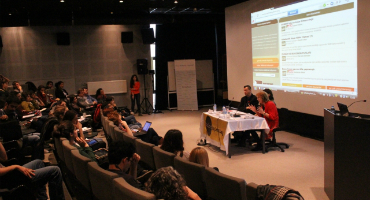As part of ASULIS Discourse, Dialog and Democracy Laboratory that has been carried out by Hrant Dink Foundation since September 2014, a panel discussion titled “Dangerous Speech/Hate Speech and Plurality in Media Panel Discussion” was held on April 28, 2015 in Havak Hall of Anarad Hığutyun Building. Susan Benesch and Dr. Elda Brogi gave speeches at the panel discussion, which was sponsored by Open Society Foundation and Istanbul Policy Center.
Moderated by Fuat Keyman from Sabanci University and Istanbul Policy Center, the panel discussion started with the speech of Susan Benesch, who is offering courses on freedom of expression and international human rights in American University in Washington DC. She is also an Everett Research Fellow at Berkman Center for Internet and Society at Harvard University.
Benesch started with the notion of “dangerous speech” that she suggested for some types of discourse that cannot be covered by the notion of “hate speech”. She stated that lack of a universal definition for “hate speech” makes it harder to use. She also noted that this ambiguity gives way to usage of this notion in favor of the dominant groups in the countries that have laws against hate speech. Adding that hate speech doesn’t always lead to violence, Benesch claimed that a definition like “dangerous speech” is more useful in society because of all these reasons. She defined “dangerous speech” as ways of communication that encourage acts of violence and/or lead to toleration or even exercise of violence by certain groups.
Providing examples of dangerous speech resulted in violence from Germany, Burma (Myanmar) and Darfur, Benesch named the five factors she suggested for determining the extent of danger that a discourse has as the following:
- The power and influence of the speaker over the audience: Is the speaker a charismatic leader or popular figure? What kind of an authority, power and influence does the speaker have over the audience?
- Audience’s position toward the discourse: Is the audience in a position that exercise violence after being subjected to the discourse, does it have the necessary means? Does the audience have an extreme respect and loyalty to the speaker?
- The content of discourse: Are the targeted groups are portrayed as non-human “beings” deserving to be subjected to violence? Does the speaker use the “mirror” strategy for giving the impression that the audience is threatened by the targeted group?
- Social and historical context: Is there a social-historical conflict between the groups in question? Are there previous instances of violence caused by other discourses?
- Means of transmission: Is the dangerous discourse spread via powerful and effective means of communication like social media and a popular TV channel or radio station? Is the dangerous discourse repeated frequently?
Benesch stated that dangerous discourse might be a warning sign that makes preventing violence possible. She said that the most commonly used method for preventing violence is counter-speech and injection (informing the audience about the purpose and implications of the dangerous speech). Giving examples from Kenya, the US and Burma, Benesch concluded her speech with the situation in Burma. Talking about Buddhist monks who launched an online campaign called “Panzagar” (flower discourse) against other Buddhist monks who use dangerous speech against Muslim minority in Burma, Benesch said that there is always hope.
Dr. Elda Brogi from Center for Media Pluralism and Media Freedom affiliated to European University Institute talked about Media Pluralism Monitor project that the Center conducts in the EU countries. Conducted in nine EU countries in 2013, the project is now conducted in other 19 EU countries.
She stated that the project monitoring the risks that threaten pluralism in media is conducted in relation to six criteria:
- Basic risk domain: conditions of freedom of expression and media freedom, environment for freedom of expression, (online) media literacy etc.
- Cultural risk domain: equality/inequality of cultural representation, minorities’ representation in media and their participation in decision-making processes in media etc.
- Geographical risk domain: equality/inequality in covering the events and developments in different places, equality/inequality in geographical representation etc.
- Media ownership risk domain: monopolization in media etc.
- Political pluralism risk domain
- Types and genres risk domain: ensuring/not ensuring the freedom and pluralism of media organs broadcasting for public interest.
Brogi emphasized that this project is particularly important for monitoring how effective EU laws that protect freedom of expression and pluralism in media in practice. She specified the project’s important contributions to media freedom and media pluralism in the EU:
Monitoring the practice and effectiveness of EU’s related policies and providing data for changing the policies when necessary; pointing out the risk domains within the EU with comparisons between countries; including the good examples that can be used as models for making changes in the countries where media freedom and pluralism is at great risk; contributing to the EU Enlargement Process by determining standards concerning media freedom and pluralism.
Benesch and Brogi concluded the panel discussion with an emphasis on the importance of academic and civil society works and social movements that are constantly developing new methods and ways of struggle in order to contribute to combating dangerous discourse and encouraging pluralism in media.




